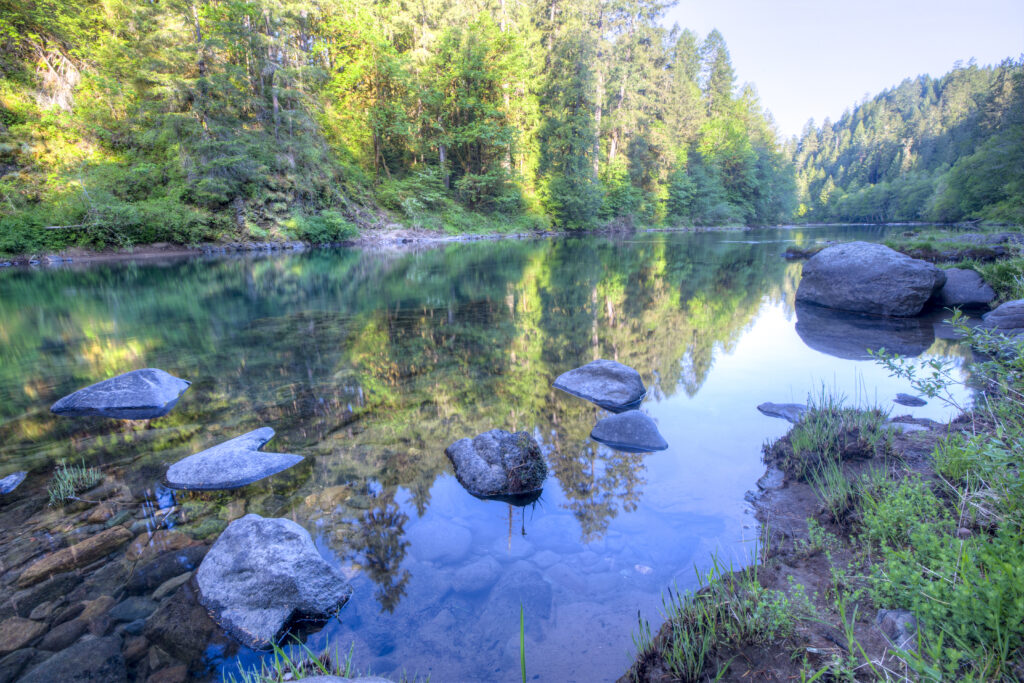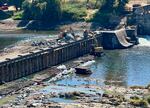
The North Umpqua River is home to endangered and threatened salmon and home to lamprey significant to the Cow Creek Band of the Umpqua Tribe of Indians.
Courtesy of Bureau of Land Management
The operators of a southern Oregon dam and the company that repaired it face additional fines for violating state permits and polluting the North Umpqua River near Roseburg.
The Oregon Department of Environmental Quality fined the Winchester Water Control District and the foundation repair company TerraFirma on Thursday more than $134,000 for violating a key state water permit and water quality laws while repairs were underway on the Winchester Dam in August and September.
The agency said the water district and company allowed concrete to spill into the river, placed unpermitted mats made of heavy truck tires in the river, potentially polluting it, and failed to provide safe passage for migrating fish.

Lamprey left exposed in the Winchester Reservoir while the Winchester Dam underwent repair.
Courtesy of Oregon Department of Fish and Wildlife
The North Umpqua is home to endangered and threatened salmon and home to lamprey significant to the nearby Cow Creek Band of the Umpqua Tribe of Indians. The Winchester Dam is also upriver from a key drinking water source for the city of Roseburg and the Umpqua Basin Water Association.
The latest fines come on top of a near-record fine from the Oregon Department of Fish and Wildlife for $27.6 million for causing the preventable deaths of more than half a million juvenile lamprey. The department alleged the company and the water district poorly executed a fish salvage plan when they drew down a reservoir, ultimately leaving the lamprey exposed and dying for days.
Ryan Beckley is owner and president of TerraFirma and president of the Winchester Water Control District. He is named in the penalties from the environmental and wildlife agencies, and told the Capital Chronicle via email that he plans to appeal the fines.
Related: The world’s largest dam removal will touch many lives in the Klamath River Basin
Latest fines
The latest fines from state environmental officials were split into two separate penalties. One, for $106,778, is for at least 10 violations of a state water permit. These include failure to control erosion and sediment, failure to maintain fish passage, exceeding the permitted amount of time to work in the water, spilling concrete into the river and failure to report that spillage.
The other fine, for $27,600, is for allowing uncured concrete – concrete not left to set for 24 hours or more – into the river and for using heavy-duty tire mats to make a temporary access road and platform in the river, potentially leaching chemicals and microplastics into the water. Despite environmental officials demanding the mats be removed, water district employees and contractors continued to use them for weeks. DEQ characterized this conduct as “flagrant” and “unlawful.”
The bulk of the latest violations are Class I, the state’s worst violation classification, but rated “moderate” for the magnitude of impact.

The 133-year-old Winchester Dam near Roseburg underwent repairs from August to early September.
Courtesy of Kirk Blaine / Native Fish Society
Winchester dam
The Winchester Dam was built in 1890 and is made of wood and cement. A former hydropower dam owned by PacifiCorp, it was given for free to more than 100 residents in the late 1960s to enjoy the 1.7-mile-long reservoir as a private lake. Residents are members of the water district, which is responsible for maintenance.
But repairs in recent years have gone awry, including an emergency fish salvage in 2013 and fines in 2018 when concrete got into the water during repairs.
The latest problems have ignited a renewed sense of urgency among environmental groups that have long wanted the dam removed. Doing so would reconnect 160 miles of North Umpqua River and allow unimpeded movement for native migratory fish.
Related: Contaminated site near Columbia’s Bonneville Dam could get top priority for Superfund cleanup
This story was originally published by the Oregon Capital Chronicle.
Oregon Capital Chronicle is part of States Newsroom, a network of news bureaus supported by grants and a coalition of donors as a 501c(3) public charity. Oregon Capital Chronicle maintains editorial independence. Contact Editor Lynne Terry for questions: info@oregoncapitalchronicle.com. Follow Oregon Capital Chronicle on Facebook and X.

